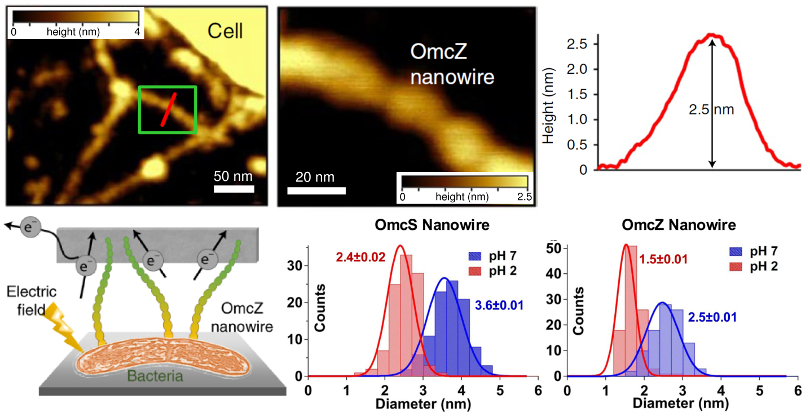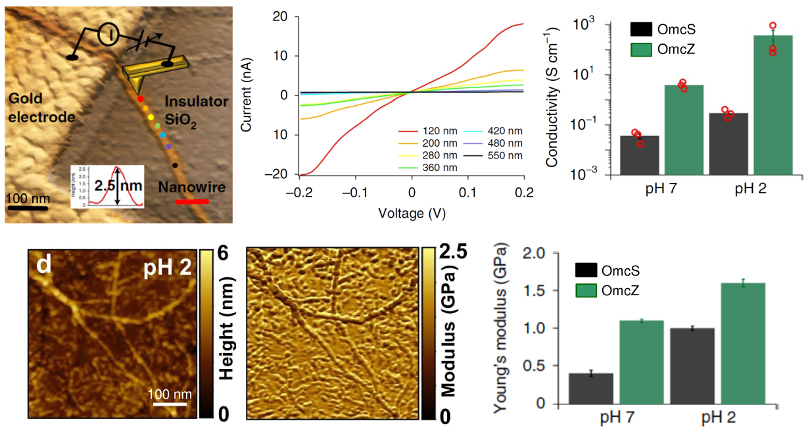AFM Systems
AFM Accessories
Learning
Contact Us
 Part of the Oxford Instruments Group
Part of the Oxford Instruments Group
Nanoscale characterization with multiple AFM modes showed that in electric fields, biofilms of Geobacter sulfurreducens bacteria produced protein nanowires with much higher electrical conductivity and stiffness. The effect was further enhanced by acidic environments.
 Living materials with electronic functionality could create a new paradigm of self-replicating, biocompatible electronics. Yet in the few biological systems known to transport charge, the conduction mechanism remains a mystery.
Living materials with electronic functionality could create a new paradigm of self-replicating, biocompatible electronics. Yet in the few biological systems known to transport charge, the conduction mechanism remains a mystery.
Yale University researchers investigated this topic using Geobacter sulfurreducens, a common soil bacterium. Previous work showed these bacteria use conductive nanowires of a protein called OmcS to remove excess electrons in a respiration process. In contrast, the current study observed that biofilms grown in an electric field produced nanowires of another protein, OmcZ.
The researchers characterized the nanowires with a suite of complementary imaging and spectroscopy tools including AFM structural, nanoelectrical, and nanomechanical modes. They found that OmcZ nanowires had 1000 times higher electrical conductivity and threefold higher stiffness than OmcS ones. Lowering the pH increased conductivity and stiffness even more, meaning the nanowires could function in acidic environments that break proteins down.
With the ability to transduce mechanical and chemical stimuli into electrical signals, the nanowires reported in these results could help bring about new kinds of durable, self-healing bioelectronics.

Cypher ES with Dual Gain ORCA module and AM-FM Viscoelastic Mapping Mode
All AFM experiments were performed on a Cypher ES AFM, including topography imaging in air with tapping mode. Sub-nanometer measurements of nanowire diameter for insight into conformational changes were enabled by the exceptional spatial resolution of Cypher AFMs. The electrical conductivity was determined by acquiring current-voltage (I-V) curves at selected positions along the nanowires. These measurements used conductive AFM (CAFM) techniques with a Dual Gain ORCA module, which contains two separate amplifiers for sensitive, low-noise current measurements over a very wide current range (~1 pA to 10 µA). Young’s modulus of the nanowires was imaged in AM-FM Viscoelastic Mapping Mode. Exclusive to Asylum Research, AM-FM is a bimodal AFM technique that allows extremely gentle modulus mapping at the fast acquisition speeds of tapping mod
Citation: S. Yalcin, J. O’Brien, Y. Gu et al., Electric field stimulates production of highly conductive microbial OmcZ nanowires. Nat. Chem. Biol. 16, 1136 (2020). https://doi.org/10.1038/s41589-020-0623-9
Note: The data shown here are reused under fair use from the original article, which can be accessed through the article link above.
